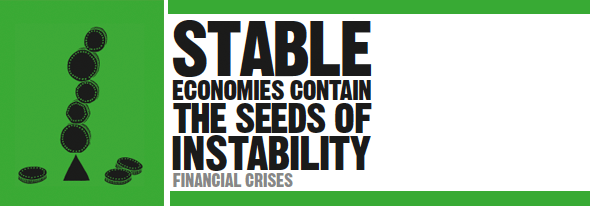

Banking and finance
Hyman Minsky (1919–96)
1933 American economist Irving Fisher shows how debt can cause depression.
1936 British economist John Maynard Keynes claims the financial markets have a larger role in the functioning of the economy than was previously thought.
2007 Lebanese-American risk theorist Nassim Nicholas Taleb publishes The Black Swan, which criticizes the risk-management procedures of financial markets.
2009 Paul McCulley, former managing director of a large US investment fund, coins the term “Minsky moment” for the point at which booms bust.
The instability of economic systems has been debated throughout the history of economic thought. The view of classical economists, following in the tradition started by Adam Smith, is that an economy is always driven toward a stable equilibrium. There will always be disturbances that create booms and slumps—a pattern that is sometimes called the business cycle—but ultimately the tendency is toward stability with a fully employed economy.
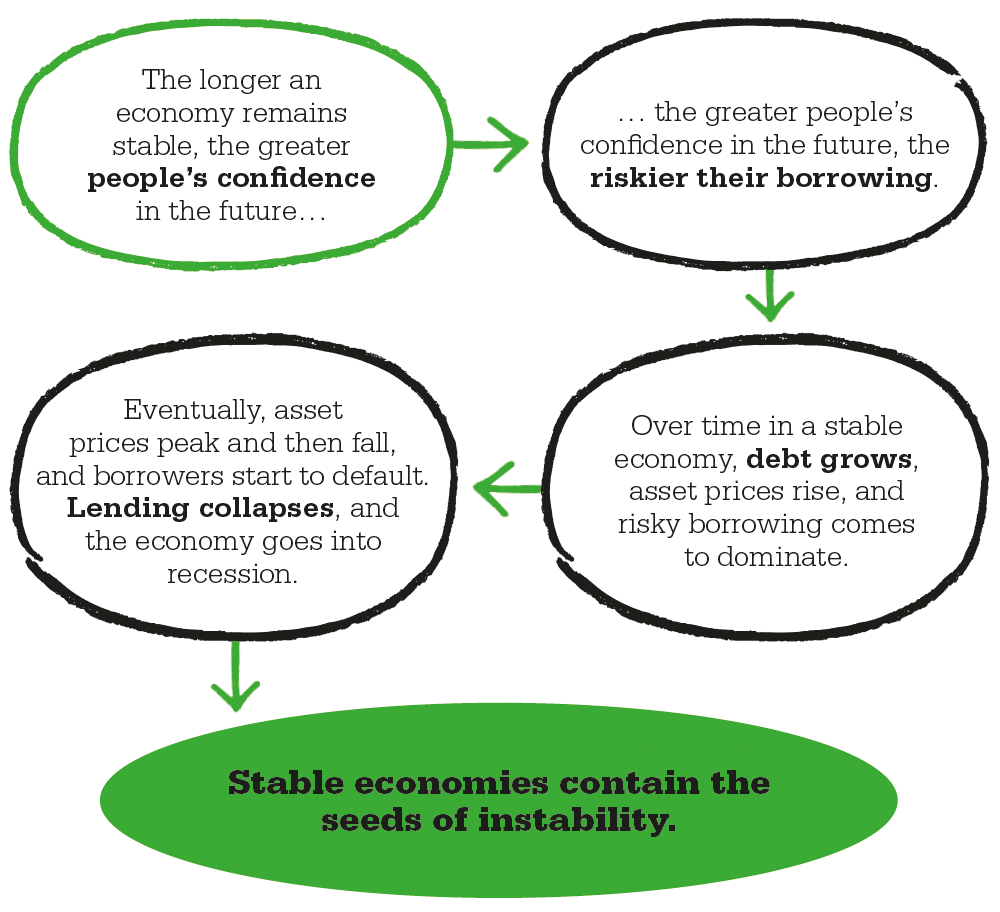
The Great Depression of 1929 led some economists to examine business cycles in more detail. In 1933, US economist Irving Fisher described how a boom can turn to bust through instabilities caused by excessive debts and falling prices. Three years later John Maynard Keynes questioned the idea that the economy is self-righting. In his General Theory, he developed the idea that an economy could settle into a depression from which it had little hope of escaping.
These works were the genesis of understanding the unstable nature of modern economies. In 1992, Hyman Minsky looked at the problem again in his paper “The Financial Instability Hypothesis.” The paper suggested that the modern capitalist economy contains the seeds of its own destruction.
In Keynes’s view the modern capitalist economy was different from the economy that had existed in the 18th century. The major difference was the role played by money and financial institutions. In 1803, the French economist Jean-Baptiste Say gave a classical interpretation of the economy as essentially a refined barter system, in which people produce goods that they exchange for money, which is used to exchange for the goods they want. The real exchange is good for good: money is just a lubricant. Keynes argued that money does more than this: it allows transactions to occur over time. A firm could borrow money today to build a factory, which it hopes will generate profit that can be used to pay back the loan and the interest in the future. Minsky pointed out that it is not only firms that are part of this process. Governments finance their national debts, and consumers borrow large sums to buy cars and houses. They too are part of the complex financial market that funds transactions over time.

Pictured here after his arrest in 1910, Charles Ponzi ran investment scams in the US promising unrealistic returns. Minsky compared capitalist booms to Ponzi schemes, doomed to collapse.
Minsky argued that there was a second big difference between modern and pre-capitalist economies. He pointed out that the banking system does not merely match lenders with borrowers. It also strives to innovate in the way it sells and borrows funds. Recent examples of this include financial instruments called collateralized debt obligations (CDOs), which were developed in the 1970s. CDOs were made by pooling different financial assets (loans) together, some high-risk, others low-risk. These new assets were then cut up into smaller sections to be sold. Each section contained a mix of debts. In 1994, credit default swaps were introduced to protect these assets by insuring them against the risk of default. Both of these innovations encouraged the supply of loans into the financial system, which increased the supply of liquidity, or money, into the system. Minsky concluded that these innovations meant that it was no longer possible for a government to control the amount of money in its economy. If the demand for loans was there, the financial markets could find a way to meet it.
"Money is a veil behind which the action of real, economic forces is concealed."
Arthur Pigou
According to Minsky, after World War II capitalist economies had moved away from being dominated by either big government or big business. Rather, they were subject to the influence of big money markets. The influence of the financial markets on the behavior of people created a system that held within it the seeds of its own destruction. He argued that the longer the period of stable economic growth, the more people believed that the prosperity would continue. As confidence rose, so did the desire to take risks. Paradoxically, longer periods of stability resulted in an economy that was more likely to become fatally unstable.
"The peculiar behavioral attributes of a capitalist economy center around the impact of finance upon system behavior."
Hyman Minsky
Minsky explained the pathway from stability to instability by looking at three different types of investment choices that people can make. These can be simply illustrated by looking at the way houses are bought. The safest decision is to borrow an amount that allows the person’s income to repay the interest on the loan and also the original value of the loan over a period of time. Minsky called these hedge units, and they create little risk for the lender or borrower. If people felt more confident about the future, they might buy a larger interest-only mortgage, where their income could pay back the interest on the loan but not the loan itself. The hope would be that a stable period of positive economic growth would increase demand so that the value of the house would be greater at the end of the period than at the start. Minsky called these people speculative borrowers.
As time passed, if stability and confidence continued to last, the desire to take greater risks would encourage people to buy a house for which their income could not even pay the interest, so that the total level of debt would increase, at least in the short run. The expectation would be that house prices would rise fast enough to cover the shortfall in the interest repayments. This third type of investment would create the greatest amount of instability in the future. Minsky named this third type of investor Ponzi borrowers after Charles Ponzi, the Italian immigrant to America who was one of the first to be caught running the financial scam that now bears his name. “Ponzi schemes” attract funds by offering very high returns. Initially, the con men use new investors’ money to pay the dividends. In this way they can maintain the illusion that investment is profitable and attract new customers. However, soon the scheme collapses due to its failure to meet the high level of returns that were promised. Investors in such schemes are likely to lose a large proportion of their money.

An agent shows a couple around a home. In the US housing boom banks were lending on the expectation of rising prices. People who could not afford mortgages were encouraged to buy.
The recent history of the US housing market is an example of how an economy that has had a long period of stability creates within itself the conditions for instability. In the 1970s and 80s the standard mortgage was sold in a way that made sure that the interest and the capital could be paid off, in what Minsky viewed as hedge units. However, by the end of the 1990s a sustained period of growth had pushed house prices up, persuading an increasing number of people to use interest-only mortgages as they speculated that prices would continue to rise. The financial system then began to supply a whole array of “Ponzi”-style mortgage deals to borrowers who had incomes so low that they could not afford to pay even the interest on the loan—these were the “subprime” mortgages. The monthly shortfall was to be added to their total debt. As long as house prices continued to rise, the value of the property would be worth more than the debt. As long as new people kept entering the market, prices kept rising. At the same time the finance industry that sold the mortgages bundled them up and sold them on to other banks as assets that would deliver a stream of income for 30 years.
The end of the game arrived in 2006. As the US economy stalled, incomes fell, and the demand for new houses weakened. As house price increases began to slow, the first of an increasing number of defaults was triggered since borrowers saw their debts grow rather than shrink. Rising numbers of repossessed houses came onto the market, and prices tumbled.
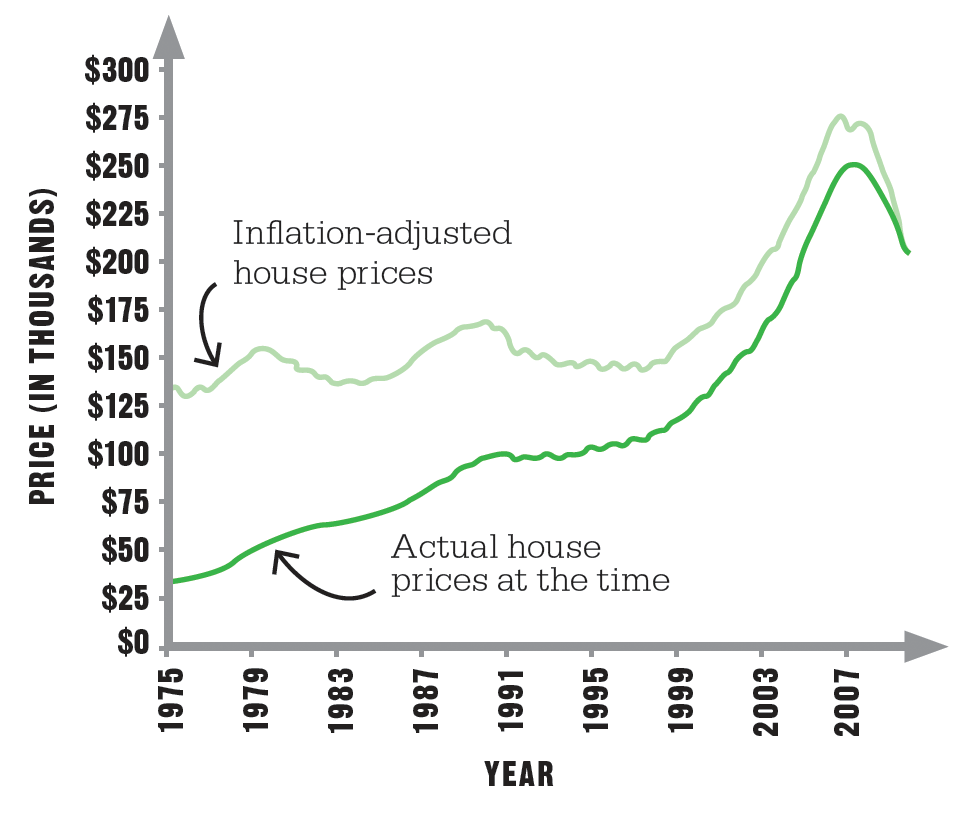
House prices in the US climbed steeply from the late 1990s until 2007 as banks increasingly granted mortgages to people without the income to pay the money back.
In 2007, the US economy reached what has become known as the “Minsky moment.” This is the point at which the unsustainable speculation turns into crisis. The collapse of the housing market left banks with enormous debts and, since no one knew who had bought the toxic mortgage debt, institutions stopped lending to each other. As a result banks began to fail, most famously Lehmann Brothers in 2008. As Minsky had foretold, a near-catastrophic collapse of the financial system beckoned because a period of stability had generated enormous levels of debt that created the conditions for enormous instability.
The three possible actions taken to halt the fatal instability, and the problems associated with making these corrections, had also been predicted by Minsky.
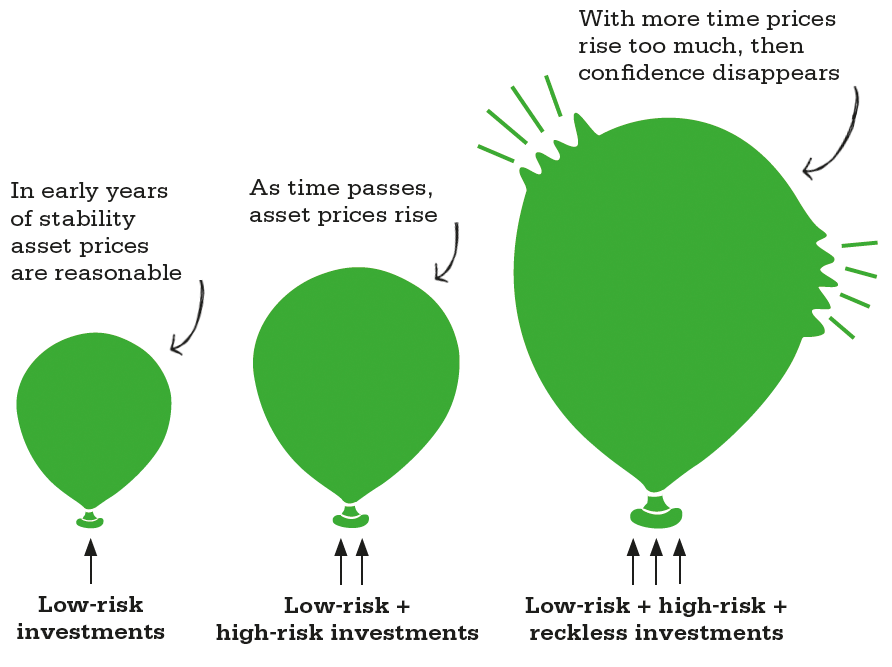
During a period of stability, confidence in the future grows, which leads people to make increasingly risky investments. This causes an asset price bubble, which will eventually burst.
First, the central bank could act as the lender of last resort, bailing out the failing banking system. Minsky saw that this might further increase instability in the system in the future because it would encourage banking firms to take greater risks, safe in the knowledge that they would be saved.
Second, the government could increase its debt to stimulate demand in the economy. However, even governments have problems financing debts in times of crisis. Third, the financial markets could be subject to stricter regulation. Minsky strongly believed that, in the long run, this was necessary. However, the speed at which innovation takes place in the money markets would make increased regulation very difficult.
For Minsky financial instability is key to explaining modern capitalism. Money is no longer a veil that hides the real workings of the economy; it has become the economy. His ideas are now drawing increasing attention.
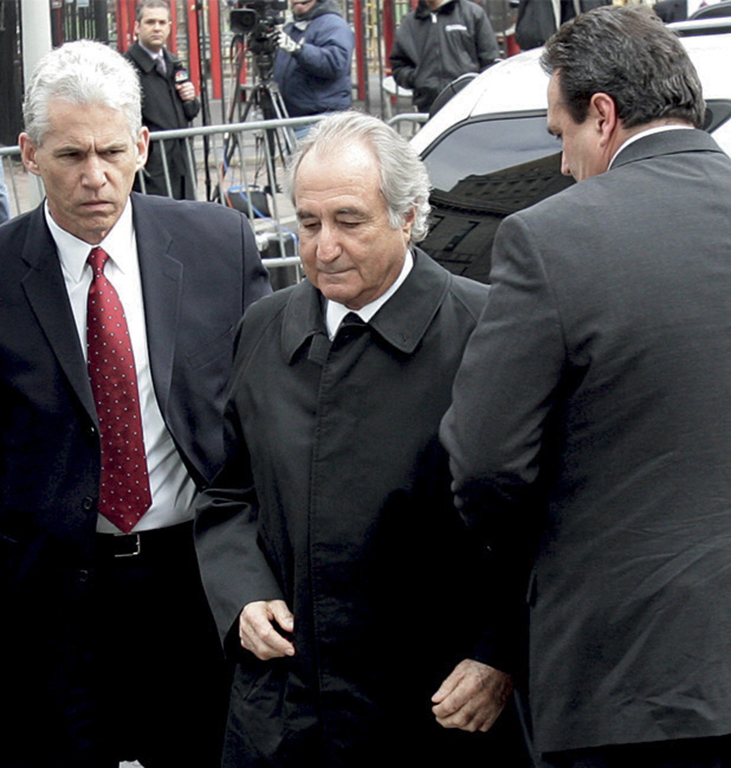
In 2009, financier Bernard Madoff was convicted of the largest Ponzi scheme fraud in history. He took more than $18 billion from investors over the course of 40 years before the scheme collapsed.
An economist of the political Left, Hyman Minsky was born in Chicago to Russian-Jewish immigrant parents who had met at a rally to honor Karl Marx. He studied mathematics at Chicago University before switching to economics.
Minsky had a vision of a better world and yet was equally fascinated by the practical world of commerce, and worked as an adviser and director of an American bank for 30 years. After a period overseas with the US army during World War II he returned home to spend most of his working life as a professor of economics at Washington University.
An original thinker and natural communicator, Minsky made friends easily. Academically, he was more interested in the idea than mathematical rigor. The notion that pervades all his work is the flow of money. During his lifetime, partly by choice, he remained on the margins of mainstream economic thought, but since his death, and particularly since the crash of 2007–08 that he predicted, his ideas have become increasingly influential. Married with two children, he died of cancer in 1996, aged 77.
1965 Labor and the War against Poverty
1975 John Maynard Keynes
1986 Stabilizing an Unstable Economy